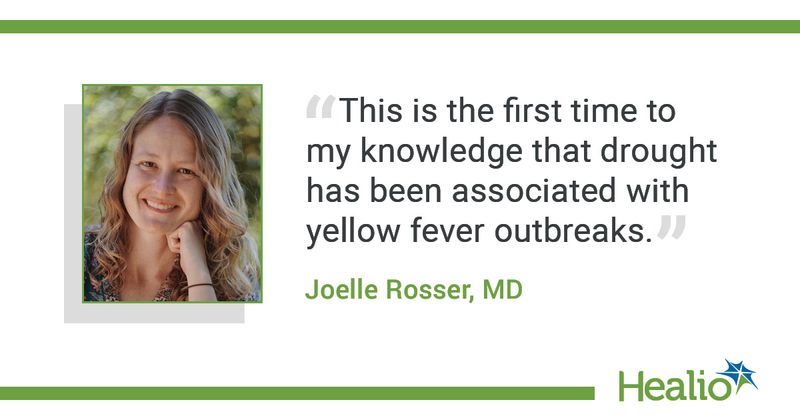Possible explanation for yellow fever's return in Brazil: Drought
Click Here to Manage Email Alerts
Drought may have led to an unusual outbreak of yellow fever in Brazil that started in 2017, according to a speaker at the American Society of Tropical Medicine and Hygiene Annual Meeting.
Joelle Rosser, MD, a fellow in the division of infectious diseases and geographic medicine at Stanford University, told Healio that she said was initially interested in climate change and its relation to vector-borne diseases “for a long time,” but her work on that topic had to be shelved once the COVID-19 pandemic hit.

“[The field work] was put on hold for a little while, and so I just started exploring a completely new topic, and dove into the literature on this yellow fever virus outbreak in Brazil,” Rosser said.
The outbreak, which Rosser called “really unusual,” occurred in 2017 and 2018, after having thought to be eradicated from this area almost 80 years ago.
“Yellow fever in Brazil had been a huge problem in the 1800s and early 1900s in the cities, but it had been eradicated from the cities in Brazil by the 1940s,” Rosser said. “It was particularly unusual and kind of caught my eye. It made me think, is there some sort of environmental trigger that's happening here?”
After examining some hypotheses that “never totally fit,” Rosser found a possible environmental factor that could have contributed to it.
“I ran across the fact that there was a drought in Brazil a couple of years leading up to this that was also being characterized as the most severe drought in this area since the 1940s,” Rosser said. “And I talked to several of my colleagues in Brazil who were there during this time, [and] they said, ‘Yeah, drought was a huge problem.’ So, I started exploring this interaction between drought and this epidemic.”
Along with her colleagues, Rosser looked at the epidemic’s origin in northeast Brazil — an area that is mostly rural and “particularly hot and dry.”
“I looked at a Drought Index across this region, across space and time, and found that the severe drought overlapped with this epidemic, and that it was particularly bad at the origin of the outbreak,” Rosser said. “So we saw that there is at least this association between drought and this outbreak. But as we know, association doesn't necessarily mean causation. So then I started exploring, asking ‘How could this drought explain the yellow fever outbreak?’”
Noting that outbreaks tended to come during the rainy seasons, Rosser saw that the drought made the area’s Haemagogus forest-dwelling mosquitoes concentrate in places where food and water was available, as well as the nonhuman primates on which they typically fed.
“When you have a high density of the mosquitoes and non-human primates in the same place, then you amplify transmission, and that can allow it to spill over into humans,” Rosser said.
The conclusion was a bit surprising, she added.
“I was not at all looking for drought to be a problem,” Rosser said. “Drought has been associated with infections such as dengue and Zika because those mosquitoes breed in water storage containers that people collect during times of drought. The yellow fever transmission in Brazil and during this epidemic came from the Haemagogus forest-dwelling mosquitoes, so it's a completely different mechanism by which drought can affect this particular vector...This is the first time to my knowledge that drought has been associated with yellow fever outbreaks.”

